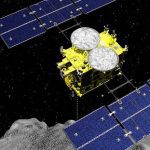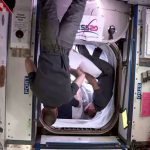A space capsule carrying a sample of rocky material removed from the surface of an asteroid three years ago is expected to make a parachute landing in the Utah desert on Sunday.
If successful, the OSIRIS-REx mission, a joint effort between NASA and scientists at the University of Arizona, would mark the third asteroid sample, and by far the largest, ever returned to Earth for analysis.
OSIRIS-REx collected its samples from Bennu, a carbon-rich asteroid, before embarking on a 1.9-billion-km (1.2-billion-mile) journey back to Earth in May 2021.
The Origins, Spectral Interpretation, Resource Identification, Security-Regolith Explorer (OSIRIS-REx) is an unmanned spacecraft from NASA that was sent to collect samples from Bennu.
The spacecraft was equipped with cameras to capture images that were essential to collecting samples from the asteroid during the mission. It was also equipped with materials to develop 3D maps of Bennu, measure its temperature, map its mineral and chemical composition, and view it in X-rays and infrared light.
The robotic arm attached to the spacecraft collected loose rocks and dirt from the asteroid’s surface, which were then sealed inside the sample return capsule.
This capsule separated from the spacecraft and began its fiery plunge through Earth’s atmosphere.
A space capsule carrying a sample of rocky material removed from the surface of an asteroid three years ago is expected to make a parachute landing in the Utah desert on Sunday.
If successful, the OSIRIS-REx mission, a joint effort between NASA and scientists at the University of Arizona, would mark the third asteroid sample, and by far the largest, ever returned to Earth for analysis.
OSIRIS-REx collected its samples from Bennu, a carbon-rich asteroid, before embarking on a 1.9-billion-km (1.2-billion-mile) journey back to Earth in May 2021.
The Origins, Spectral Interpretation, Resource Identification, Security-Regolith Explorer (OSIRIS-REx) is an unmanned spacecraft from NASA that was sent to collect samples from Bennu.
The spacecraft was equipped with cameras to capture images that were essential to collecting samples from the asteroid during the mission. It was also equipped with materials to develop 3D maps of Bennu, measure its temperature, map its mineral and chemical composition, and view it in X-rays and infrared light.
The robotic arm attached to the spacecraft collected loose rocks and dirt from the asteroid’s surface, which were then sealed inside the sample return capsule.
This capsule separated from the spacecraft and began its fiery plunge through Earth’s atmosphere.
A space capsule carrying a sample of rocky material removed from the surface of an asteroid three years ago is expected to make a parachute landing in the Utah desert on Sunday.
If successful, the OSIRIS-REx mission, a joint effort between NASA and scientists at the University of Arizona, would mark the third asteroid sample, and by far the largest, ever returned to Earth for analysis.
OSIRIS-REx collected its samples from Bennu, a carbon-rich asteroid, before embarking on a 1.9-billion-km (1.2-billion-mile) journey back to Earth in May 2021.
The Origins, Spectral Interpretation, Resource Identification, Security-Regolith Explorer (OSIRIS-REx) is an unmanned spacecraft from NASA that was sent to collect samples from Bennu.
The spacecraft was equipped with cameras to capture images that were essential to collecting samples from the asteroid during the mission. It was also equipped with materials to develop 3D maps of Bennu, measure its temperature, map its mineral and chemical composition, and view it in X-rays and infrared light.
The robotic arm attached to the spacecraft collected loose rocks and dirt from the asteroid’s surface, which were then sealed inside the sample return capsule.
This capsule separated from the spacecraft and began its fiery plunge through Earth’s atmosphere.
A space capsule carrying a sample of rocky material removed from the surface of an asteroid three years ago is expected to make a parachute landing in the Utah desert on Sunday.
If successful, the OSIRIS-REx mission, a joint effort between NASA and scientists at the University of Arizona, would mark the third asteroid sample, and by far the largest, ever returned to Earth for analysis.
OSIRIS-REx collected its samples from Bennu, a carbon-rich asteroid, before embarking on a 1.9-billion-km (1.2-billion-mile) journey back to Earth in May 2021.
The Origins, Spectral Interpretation, Resource Identification, Security-Regolith Explorer (OSIRIS-REx) is an unmanned spacecraft from NASA that was sent to collect samples from Bennu.
The spacecraft was equipped with cameras to capture images that were essential to collecting samples from the asteroid during the mission. It was also equipped with materials to develop 3D maps of Bennu, measure its temperature, map its mineral and chemical composition, and view it in X-rays and infrared light.
The robotic arm attached to the spacecraft collected loose rocks and dirt from the asteroid’s surface, which were then sealed inside the sample return capsule.
This capsule separated from the spacecraft and began its fiery plunge through Earth’s atmosphere.
A space capsule carrying a sample of rocky material removed from the surface of an asteroid three years ago is expected to make a parachute landing in the Utah desert on Sunday.
If successful, the OSIRIS-REx mission, a joint effort between NASA and scientists at the University of Arizona, would mark the third asteroid sample, and by far the largest, ever returned to Earth for analysis.
OSIRIS-REx collected its samples from Bennu, a carbon-rich asteroid, before embarking on a 1.9-billion-km (1.2-billion-mile) journey back to Earth in May 2021.
The Origins, Spectral Interpretation, Resource Identification, Security-Regolith Explorer (OSIRIS-REx) is an unmanned spacecraft from NASA that was sent to collect samples from Bennu.
The spacecraft was equipped with cameras to capture images that were essential to collecting samples from the asteroid during the mission. It was also equipped with materials to develop 3D maps of Bennu, measure its temperature, map its mineral and chemical composition, and view it in X-rays and infrared light.
The robotic arm attached to the spacecraft collected loose rocks and dirt from the asteroid’s surface, which were then sealed inside the sample return capsule.
This capsule separated from the spacecraft and began its fiery plunge through Earth’s atmosphere.
A space capsule carrying a sample of rocky material removed from the surface of an asteroid three years ago is expected to make a parachute landing in the Utah desert on Sunday.
If successful, the OSIRIS-REx mission, a joint effort between NASA and scientists at the University of Arizona, would mark the third asteroid sample, and by far the largest, ever returned to Earth for analysis.
OSIRIS-REx collected its samples from Bennu, a carbon-rich asteroid, before embarking on a 1.9-billion-km (1.2-billion-mile) journey back to Earth in May 2021.
The Origins, Spectral Interpretation, Resource Identification, Security-Regolith Explorer (OSIRIS-REx) is an unmanned spacecraft from NASA that was sent to collect samples from Bennu.
The spacecraft was equipped with cameras to capture images that were essential to collecting samples from the asteroid during the mission. It was also equipped with materials to develop 3D maps of Bennu, measure its temperature, map its mineral and chemical composition, and view it in X-rays and infrared light.
The robotic arm attached to the spacecraft collected loose rocks and dirt from the asteroid’s surface, which were then sealed inside the sample return capsule.
This capsule separated from the spacecraft and began its fiery plunge through Earth’s atmosphere.
A space capsule carrying a sample of rocky material removed from the surface of an asteroid three years ago is expected to make a parachute landing in the Utah desert on Sunday.
If successful, the OSIRIS-REx mission, a joint effort between NASA and scientists at the University of Arizona, would mark the third asteroid sample, and by far the largest, ever returned to Earth for analysis.
OSIRIS-REx collected its samples from Bennu, a carbon-rich asteroid, before embarking on a 1.9-billion-km (1.2-billion-mile) journey back to Earth in May 2021.
The Origins, Spectral Interpretation, Resource Identification, Security-Regolith Explorer (OSIRIS-REx) is an unmanned spacecraft from NASA that was sent to collect samples from Bennu.
The spacecraft was equipped with cameras to capture images that were essential to collecting samples from the asteroid during the mission. It was also equipped with materials to develop 3D maps of Bennu, measure its temperature, map its mineral and chemical composition, and view it in X-rays and infrared light.
The robotic arm attached to the spacecraft collected loose rocks and dirt from the asteroid’s surface, which were then sealed inside the sample return capsule.
This capsule separated from the spacecraft and began its fiery plunge through Earth’s atmosphere.
A space capsule carrying a sample of rocky material removed from the surface of an asteroid three years ago is expected to make a parachute landing in the Utah desert on Sunday.
If successful, the OSIRIS-REx mission, a joint effort between NASA and scientists at the University of Arizona, would mark the third asteroid sample, and by far the largest, ever returned to Earth for analysis.
OSIRIS-REx collected its samples from Bennu, a carbon-rich asteroid, before embarking on a 1.9-billion-km (1.2-billion-mile) journey back to Earth in May 2021.
The Origins, Spectral Interpretation, Resource Identification, Security-Regolith Explorer (OSIRIS-REx) is an unmanned spacecraft from NASA that was sent to collect samples from Bennu.
The spacecraft was equipped with cameras to capture images that were essential to collecting samples from the asteroid during the mission. It was also equipped with materials to develop 3D maps of Bennu, measure its temperature, map its mineral and chemical composition, and view it in X-rays and infrared light.
The robotic arm attached to the spacecraft collected loose rocks and dirt from the asteroid’s surface, which were then sealed inside the sample return capsule.
This capsule separated from the spacecraft and began its fiery plunge through Earth’s atmosphere.














